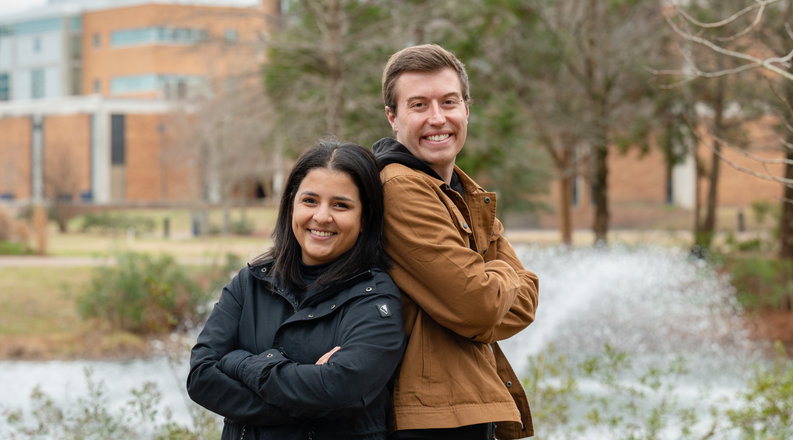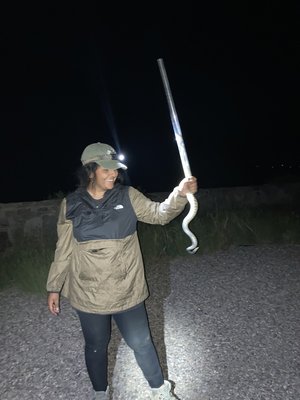By Jonah Grinkewitz
Before she had her first experience working in the field, Karen Caceres was timid about touching wild animals.
“We had a captive experiment (in the lab) and I was very fidgety about touching the mice,” she said.
Then she traveled to New Mexico to gather blood samples from rattlesnakes, requiring her to get up close and personal with an even more intimidating species.
“I was so nervous before my trip, but by your third or fourth day camping out in the desert looking for rattlesnakes, you buck up,” she said.
Caceres, a master’s student studying biological sciences at Old Dominion University, was part of a team examining water intake in certain animals.
Animals, and humans, get almost all their water from three sources: drinking, food and metabolism. The faster your metabolism, the more water is created. Since reptiles don’t drink much water and have a low metabolism, scientists generally think they depend mostly on eating for water.
Testing that theory has been a challenge because the common method for studying where animals get their water involves injecting them with a labeled isotope tracer and recapturing them to complete the process.
“Obviously, that takes a lot of logistics, a lot of resources. It’s difficult to capture the animal again, and you’re putting extra stress on them,” said Zach Steele, a Ph.D. student studying biological sciences at ODU who also went on the trip.
Using a new technique developed by ODU Assistant Professor John Whiteman and researchers at the University of New Mexico and University of Massachusetts-Amherst, researchers need only one sample from animals.
“Since we haven’t really been able to see before whether metabolic water matters in the wild for reptiles, this can open pathways for other researchers to look at other species,” Caceres said.
The students did their research in a biodiverse region overlapped by the Chihuahuan Desert, the Rocky Mountains and the central grasslands of the U.S. Southwest.
Steele had two research goals. First, he gathered samples from kangaroo rats – a unique species that is “water independent,” meaning they don’t drink any water, but instead get theirs completely from food and what they synthesize in their body through metabolism.
The second part was applying the sampling technique to a real-world situation. In New Mexico, there is an invasive species called the South African oryx, which was introduced by the New Mexico Department of Game and Fish (NMDGF) in the 1960s to attract hunters.
“They’re an extreme specialist that can go a long time without needing water, and then when there is water, they can outcompete native species for it,” said Steele.
The oryx population has exploded from around 90 in the 1970s to more than 2,000 currently. In addition to outcompeting other animals, it lives on the White Sands Missile Range and sometimes disrupts military operations and causes fatal car collisions.
Steele partnered with White Sands and the NMDGF to recruit hunters to gather blood samples from the animals.
“What we’re trying to figure out is, during different times of the year, how much of their water is coming from that internal source (metabolism),” Steele said. “If they’re able to shift this at different points of the year, it would allow them to potentially outcompete other species in the area like bighorn sheep, mule deer, pronghorn and different antelopes.”
They also asked the hunters to fill out a survey on how they feel about the oryx population and how they think the population should be managed. The ecological data, combined with the survey, will make it easier for the region’s stakeholders to make an informed decision.
Whiteman said it is crucial for scientists to get out of the lab.
“In science, we start with a complicated phenomenon, then we remove factors that we don’t think are important until we are left with just the bare minimum of information that is needed to understand the phenomenon,” he said. “If you start that process with an incomplete understanding – for example, by working with samples that come from a study site that you have never visited – you are at an immediate disadvantage.”
Steele, who has worked in the field many times, said it can be tough when you aren’t sleeping much, and you have to go two or three weeks without showering or changing your clothes.
“But, at this point, you’re with a lot of people who’ve had a similar experience,” he said. “So, you get out in the field and usually have a great time.”
The students hope to return to New Mexico for more research in March or June.
Caceres, whose proudest moment is now holding a rattlesnake, said she will be looking for “pretty much any samples I can get my hands on.”




